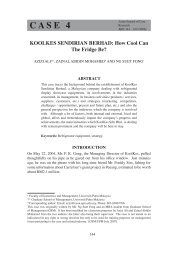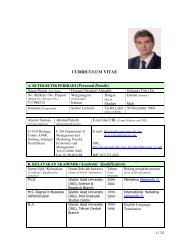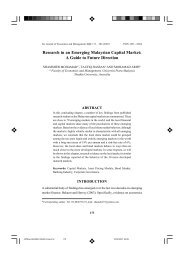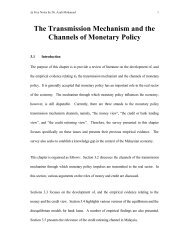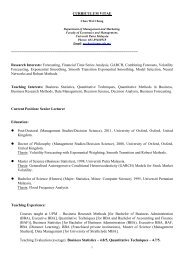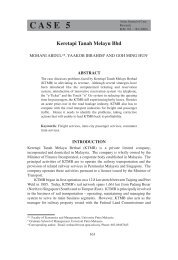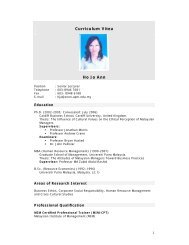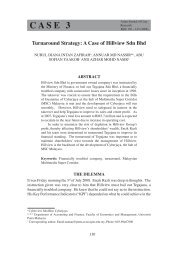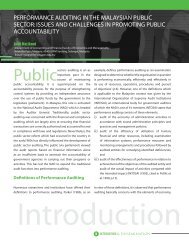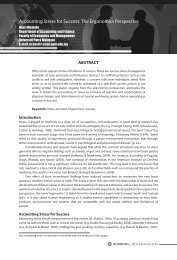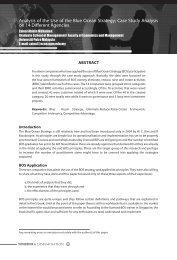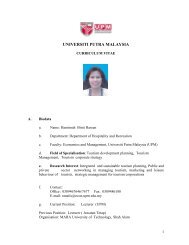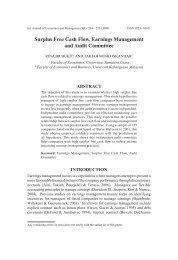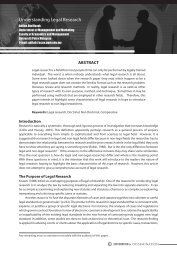Cultural Dimensions Among Malaysian Employees - Universiti Putra ...
Cultural Dimensions Among Malaysian Employees - Universiti Putra ...
Cultural Dimensions Among Malaysian Employees - Universiti Putra ...
Create successful ePaper yourself
Turn your PDF publications into a flip-book with our unique Google optimized e-Paper software.
Int. Technical Journal of Efficiency Economics of Small and Management and Medium 2(2): Enterprise 409 – in 426 Malaysia: (2008) A Stochastic ISSN 1823 Frontier - 836X<strong>Cultural</strong> <strong>Dimensions</strong> <strong>Among</strong> <strong>Malaysian</strong> <strong>Employees</strong>*DAHLIA ZAWAWIDepartment of Management and Marketing, Faculty of Economics and Management,<strong>Universiti</strong> <strong>Putra</strong> MalaysiaABSTRACTThis study explores the similarities and differences of cultural valuesamong the Malay, Chinese, and Indian management employees inMalaysia, mainly via a case study of Nestlé in Malaysia, one of themajor multinational organisations in the country. Qualitative approachwas taken where 13 management employees were interviewed. Thisstudy shows several new patterns of cultural values emerging among theemployees of Nestlé in Malaysia. Primarily, it extends the literature, byproviding further understanding on the issues of cultural values on the<strong>Malaysian</strong> society.Keywords: <strong>Cultural</strong> values, Malaysia, Nestlé, Qualitative approach.INTRODUCTIONThe concept of culture has gained its popularity and strength for several reasons.Tayeb cites these strengths as relating to ‘(1) the fact that cultural values andattitudes are different in degree at least, if not in absolute terms, in some cases fromone society to another, (2) the fact that different cultural groups behave differentlyunder similar circumstances because of the differences in their underlying valuesand attitudes, and (3) the important role that culture plays in shaping workorganisations and other social institutions’ (Tayeb, 1994, p.429). In reality, culture* Corresponding author: E-mail: dahlia@econ.upm.edu.myAny remaining errors or omissions rest solely with the author(s) of this paper.409
International Journal of Economics and Managementactually encompasses a very general and broad concept which will require years tostudy. As a result, many researchers study culture according to its many layers.The lengthy definition of culture has continued to be applied until today, eitherpartly or wholly, by researchers. All these ideas of culture are combined into thedefinition proposed by Rijamampianina saying that, ‘culture is created, acquired,and/or learned, developed and passed on by a group of people, consciously orunconsciously, to subsequent generations. It includes everything that a groupthinks, says, does, and makes – its customs, ideas, mores, habits, traditions,language, and shared systems of attitudes and feelings – that help to createstandards for people to co-exist’ (Rijamampianina, 1996, p.124). When used incomparison, culture is usually considered as an independent environmental factorspecific to one country (Nicolaidis, 1991, p.3). Hofstede infers in his many wordsthat membership of a particular culture of a nation is usually permanent (1994).Javidan and House state culture to be a set of values and beliefs of desirable andundesirable things among the members of a society with a set of formal and informalcustoms to support the values (2001, p.292). When related to nationality, culturebecomes the shared values among individuals within a certain national environment(Anwar and Chaker, 2003, p.44). Hofstede acknowledges the existence of variationsin behaviour among the members of any culture. According to him, cultural patternsonly show the possible and understandable reactions and behaviour based onone’s past. It is impossible to have all individuals from one particular countrybehaving exactly the same (Hofstede, 1991).LITERATURE REVIEWCulture is not just a tool for coping, but it is also meant for creating awareness orlearning. It underpins human activities and helps explain much of human behaviour.Most of the studies on culture aimed to discover the similarities and differencesbetween people from the same or totally different cultural environments. Thesimilarities and differences in culture are explained in its two common theories ofculture involving the concept of convergence and divergence.Findings on cultural research have revealed support for both divergent andconvergent theories. A large number of studies carried out on culture are based onthe understanding that the cultures of people from various ethnic backgrounds orgroups bear some differences (e.g. Ford and Honeycutt Jr, 1992, Hartog et al., 1997,Mwaura, Sutton and Roberts, 1998, Raghuram, London and Larsen, 2001, Shardaand Miller, 2001, Anwar and Chaker, 2003, Ryckman and Houston, 2003). Thisassumption of diversity is indirectly related to the divergent concept of culture.Some authors like Hofstede, through their research, conclude that the convergenceof management will never come (1983). However, some studies have shown opposite410
Technical Efficiency of Small and Medium Enterprise in Malaysia: A Stochastic Frontierresults especially at a subcultural level (e.g. Miller and Mahmoudi, 1986, Heuer,Cummings and Hutabarat, 1999, Budhwar and Sparrow, 2002).The relationship between culture and values has been mentioned by manyprominent researchers studying culture (e.g. Hofstede, 1991, Trompenaars, 1993,Abdullah, 1996). Studies on values are normally conducted within one nation, orbetween a few countries. Replications of prominent studies or even questionnairesfrom reputable researchers are seen in most cases.One of the most replicated questionnaires adopted is the one developed byRokeach (1967, 1973) called the Rokeach Value Survey (RVS). His method was toname the values, briefly explain the meanings, and then ask respondents to arrangethe values in their order of importance. Following Rokeach’s study, a series of largescale studies of values were undertaken by Schwartz and his collaborators (Schwartzand Bilsky, 1990, Schwartz, 1992, Schwartz, 1994). Schwartz made a detailed reviewof earlier theories and studies of values from both Western and non-Western sources.His contributions included the derive of ten motivational individual-level andcultural-level value types.Several local researchers have also shown an interest in looking at the pluralisticculture of Malaysia. However, the scope of these studies is still considered quitelimited, with most failing to take into consideration all the main races in the country(e.g. Wah, 1993, Tamam, Hassan and Said, 1996, Kasa and Lope Pihie, 1997, Ward,Pearson and Entrekin, 2002). The most extensive study so far on the main races inMalaysia regarding cultural values would probably be the one conducted byAbdullah (2001). Abdullah used findings obtained from a series of conferences,workshops and seminars conducted in 1990-1992 by the <strong>Malaysian</strong> Institute ofManagement (with sponsorship from the Konrad Adenauer Foundation) to comeup with a list of ethnic values in Malaysia. A further, similar study was carried out toinvestigate the similarities and differences in cultural dimensions among Anglosaxons,Australians and <strong>Malaysian</strong>s (Abdullah and Lim, 2001c).It should be noted that a large number of studies carried out on Malaysia havetended to reflect the needs and interests of the researchers involved. So far, nostudy has been conducted for the sole purpose of guiding organisations in Malaysiato gain full advantage of the nation’s diverse populations. Across the studies doneby Abdullah (1996), Tamam, Hasan and Said (1996), Kasa and Lope Pihie (1997), andWard, Pearson and Entrekin (2002) several values are found to be similar such ascollectivism, security, career development or success, economic returns or money,thrift, and preservation of face.Most of the studies conducted on <strong>Malaysian</strong>s failed to extensively incorporateall the three main races as samples. As such, it remains unclear whether the findingscan be fully applied to or fully generalise the <strong>Malaysian</strong> workforce. Since no otherstudies is carried out to explore possible variances in values in terms of the differentraces in Malaysia, the study of Abdullah (1996) remains unchallenged. More studies411
International Journal of Economics and Managementare therefore needed to explore the current status of variations among the populationof Malaysia to help update the existing literature.METHODSemi-structured interviews were conducted to generate a deeper understanding ofthe phenomenon surrounding the issue on cultural values. In the beginning, 17management employees from Nestlé in Malaysia were chosen randomly from theclusters of the main ethnic backgrounds (Malays, Chinese, and Indians) for interview.However, out of that total, 4 were not available during the times allocated andallowed by Nestlé in Malaysia. In the end, only 13 management employees wereinterviewed for this study.The material recorded in the interviews was transcribed immediately after thesessions had ended. Since the spoken language in the interviews was mainlyEnglish, the transcriptions were reported as they conversed, although translationswere sometimes required in a few parts of the transcription and note-takingprocesses. The notes taken during the remaining interviews were also refined assoon as possible while the information was still fresh. Any quotations recordedwere carefully written to avoid any confusion later on. Since not all of the interviewswere tape recorded, software was not used in analysing them. Instead, the dataanalysis was done manuallyIn an effort to discuss the interviews, all the participants are explained asindividual cases. The participants are identified with the letters A to M with theletter I added in front of each letter identifying them as contributors to the in-depthinterviews. For an example, participant A was called participant IA.BACKGROUND TO RESPONDENTSOf the 13 interviewees, six were Malays (46.2 per cent), four were Chinese (30.8 percent) and three were Indians (23.1 per cent). To add, 46.2 per cent were male employees(six interviewees) while another 53.8 per cent were female employees (seveninterviewees). Finally, nine interviewees worked as executives (69.2 per cent) whileanother four interviewees were managers (30.8 per cent). Normally, the ‘executive’term in Malaysia included any individuals with a qualification of a diploma or higherand whose job title and job description was ‘executive’ or the equivalent while themanagers included individuals with a qualification of a degree or higher and whosejob title and job description was ‘manager’ or the equivalent.From the total number, only 3 participants had worked in the organisation formore than 20 years. The length of employment of all the other participants wasbetween 2 and 7 years. These distributions correlated with the age of the participants,in which the ones who had worked longer were mostly older. In addition, only 4 had412
Technical Efficiency of Small and Medium Enterprise in Malaysia: A Stochastic Frontieroverseas degrees or work experience with other organisations. The rest of thegroup were mostly locally educated, and some considered Nestlé in Malaysia astheir first employer.RESEARCH FINDINGSIn order to find the similarities and differences across the ethnic backgrounds,employees were asked about the values they adopted before and after they joinedthe organization. All these cultural values are summarised accordingly in Figure 1and Figure 2.Throughout the interviews, several similar cultural values shared by the threeraces were discovered. However, there were no cultural values mentioned specificallyby each set of race. Of all the values, there was only one value, Politeness (Sopan-MalaysChinese• Ambitious• Filial Piety• Honesty• Knowledgeable• Trustworthiness• Piousness• Politeness(sopan-santun)• Rituals andTraditionsIndiansFigure 1Important Values and Beliefs of the Malays, Chinese and IndiansBefore They Joined Nestlé in Malaysia413
International Journal of Economics and ManagementMalaysChinese• Ambitious*• Tact• Accommodating• Authoritative• Self-confidence• Wisdom• ModestyIndians* - This value was inserted again here to indicate the increased number of respondentsadopting it once they started working for Nestlé in MalaysiaFigure 2Important Values and Beliefs of the Malays, Chinese and IndiansAdded After They Joined Nestlé in Malaysiasantun), which was highlighted to be important by all three races. The Malays andthe Chinese were seen to have the most similar cultural values, which wereAmbitious, Filial Piety, Honesty, Knowledgeable, and Trustworthiness. The Malaysand Indians were only similar in their value of Piousness, while the Chinese andIndians were similar in their values of Rituals and Traditions.The cultural values that were common among the Malays and Chineseparticipants were Ambitious, Filial Piety, Honesty, Knowledgeable, andTrustworthiness. Not surprisingly, the Malays shared the value of Filial Piety withthe Chinese where emphasis was put on minding and respecting the parents. BecauseNestlé in Malaysia consisted of a number of expatriates from various countries inaddition to the multi-racial employees, trust (Trustworthiness) was also taken as avery important value. Trust was an essential value between people working together.When trust was present, delegation of tasks and responsibilities was easier. The414
Technical Efficiency of Small and Medium Enterprise in Malaysia: A Stochastic Frontierfact that both races focused on being Knowledgeable inferred that they too placedgreat importance on education. Although the Chinese were always known to giveimportance to education for over a long time, this discovery suggested a change ofperception for the Malays. Several statements supporting the value are as follows:“My parents always encourage me to study hard until now. They always preachon the importance of education when I was little.” [Participant IH]“Last time it is more on personal development, learning the job. Learning ismore important than the monetary side.” [Participant ID]At the same time, both races were also taught the need to be ambitious ineverything that they did. However, from the quotations of a Chinese manager(Participant IA) and a Malay executive (Participant IJ) below, it appeared that,unlike the Malays, the Chinese encouraged their young ones to be the best byusing direct and obvious approaches. On the contrary, the Malays had to infer theneed to excel from the behaviour of her mother.“At school I was encouraged to try my best in everything. Although at times Imay not get to be number one, I was taught to be competitive.” [Participant IA]“At home, I often see my mother trying her best to serve delicious food for ourrelatives and friends. In fact she will try her best in everything she does. Ilearned a lot from her.” [Participant IJ]The Malays and the Indians had one similar cultural value, which was Piousness.Apart from good conduct, the Malays were always presumed to be religious people.Two of the Malay participants stated that they had been exposed to religiouseducation and laws since their childhood. As they explained:“I learned about Islam all the time. If not from my teachers, I will learn from myparents.” [Participant IC]“The Malays have been exposed to religious values from young. Concepts suchas ‘halal’ and ‘haram’ have long become part of their lives.” [Participant IK]Note: Halal means legally permissible by Islam and Haram means legally forbiddenby IslamThe importance of this particular value is usually recognised by organisationswhere the Malays were permitted to take some time to pray in the praying rooms. OnFridays, longer lunch times were normally allowed for male Muslims to enable themto perform their Friday prayers, which was a requirement of their religion.415
International Journal of Economics and ManagementMoreover, the Chinese and Indians were similar in their cultural values ofRituals and Traditions. <strong>Among</strong> the traditions that were spoken of were therelationship between boys and girls, marital arrangement and ways of eating. Duringthe interview, an Indian employee mentioned:“Indian girls should not mix with Indian boys. During my school time, I hadmale friends, but none was an Indian.”[Participant IG]“My marriage was arranged by my family and my husband’s family. I wasmarried to one of my male relatives.” [Participant IG]Another Chinese respondent stated the following:“As a Chinese you must know how to use the chopsticks the proper way andthen whenever you go to other people’s house you must know how to callpeople, how to greet people, before you eat, how you say, ‘excuse me’ that kindof thing.” [Participant IE]There was only one common cultural value that was similar for all the threemain races, which was Politeness (Sopan-santun). In this case, Politeness (Sopansantun)was marked by polished manners and by respect for and consideration ofothers, and covered a wide range of other values such as courtesy, gratefulness,and kindness. Examples of the importance of Politeness (Sopan-santun) arementioned below:“When you start reading about God, the learning will guide you. Good attitudewill follows.” [Participant IG]“I was trained to talk, behave and dress properly by both my parents andteachers.” [Participant IH]“Principally, the one value that I would not forget is manners.” [ParticipantID]There were also several other values thought to originate from culture thatwere believed by each of race individually without overlapping with one another.Since these values were mentioned only once, they were not included in Figure 1.For example, one of the Malay interviewees also believed in having a balance inwork and life (Work/life Balance). Although Nestlé in Malaysia was a very demandingorganisation, she tried very hard to divide her time equally. She explained:“I strongly believe in having a good family. My life and work need to have abalance. Whatever I instil in myself, I would want to see it in mychildren.”[Participant IM]416
Technical Efficiency of Small and Medium Enterprise in Malaysia: A Stochastic FrontierOther values of the Malays include Affiliation, Appreciative, Fairness, Loyalty,and Obedience. An interesting value indicated by one of the Malay participants inthe interview was the value of Individualism. This has been inferred as the importanceto the Malays of being concerned with themselves rather than the group, whichopposes some of the findings found in the literature. The Work/life Balance valueindirectly suggested the Malays’ preference for a moderate burden at work toenable them to focus on their families. The idea that family was important hereseems to contrast with the previous Individualism value. One more value proposedby another Malay participant was Indirectness. This value was seen to be related tothe value of Politeness (Sopan-santun), and the need to be polite. In general, theMalays viewed being direct as inappropriate in most situations. Even if it was apositive thing, an individual should try to be indirect when expressing theircomments or opinions.As for the Chinese, one participant mentioned the value of Lifelong Learning.However, the same Chinese interviewee revealed an interesting point. According tohim, he had been taught to continuously learn new things, but he was asked torefrain himself from being competitive. He stated:“During school, the students were encouraged to continuously learn ratherthan engaging themselves in unhealthy competitions.”[Participant IB]The statement showed a contrast with the Kiasu value, which focuses onbeing competitive with others. The same individual also raised the importance ofmaintaining a peaceful environment (Harmony) between the races. Concurrently,he was educated by his parents to always Respect other Races and Religions.Recalling what had been told by his father, he stated:“As I grow up, I was exposed to different thoughts and point of views. My fatheralways told me to respect other races and other religions.”Since Malaysia is a multi-racial nation, people from different races and religionneed to understand and respect one another to avoid disagreements.Most of the Chinese focused heavily on individual growth. Apart from LifelongLearning, there was also the value of Self-improvement. In addition, the Chinesecontinued to believe in their ancient values such as Filial Piety and Reciprocation ofFavours. These values are closely related to each other, but they are not exactly thesame. While Filial Piety relates only to the parents, Reciprocation of Favours coversa larger territory that involves all acquaintances known to the individual. In thiscase, a Chinese male acknowledged the fact that he had a responsibility to help hisparents and at the same time return the kindness shown by the people around himeither tangibly or intangibly. As he mentioned during the interview:417
International Journal of Economics and Management“I should help my family after I got a good job. They sacrificed a lot forme.”[Filial Piety][Participant IB]“I was taught not to forget the people who have sacrificed for me. I am to returnthe favours whenever there are chances to do so. Once I have started working,I began to give a certain amount of money to my parents to help them in their olddays. They have sacrificed a lot for me and now it is time for me to pay back.”[Reciprocation of Favours][Participant IB]On the other hand, the Indians were taught to value Self-confidence and Selfrespect.For them, when individuals were confident of their own abilities, theywould be able to achieve anything. As stated by an Indian male:“Once I joined Nestlé, I realised that I need to build up my self-assurance. Eventhough it is a hard task, I must try.”[Self-confidence][Participant IL]“My parents and teachers always told me to believe in myself.”[Selfrespect][ParticipantIL]Furthermore, the Indians also favoured the Authoritative value. Indirectly, thisvalue showed the importance to the Indians of being in command. They cameacross as eager to accept the responsibilities that came with being in charge of anyevents.The degree of importance placed on these cultural values was subjected to afew changes when these participants started working for Nestlé in Malaysia. Morecultural values were now added (Figure 2) to the previous complement of culturalvalues found in Figure 1 as the need to adopt a new set of values became essentialin their work environment. In contrast to Figure 1, some of the cultural values inFigure 2 were included due to them being referred to by more respondents as valuesthat they acquired after they joined the organization. However, the value ofAmbitious was simply stated again in Figure 2 due to the increase in the number ofrespondents adopting it once they started working for the organisation.Apart from the similarities presented in Figure 1, more interesting similaritiessurfaced between the three races after joining the organization (Figure 2). Forexample, the Malays and the Indians now considered Wisdom as important.According to them:“It is important to make people understand when you explain something. To dothat, you should understand the problem first.” [Participant IJ]“You have to be matured in anything you do. You have to experience variousways in order to interact effectively with people around you. You must also learn418
Technical Efficiency of Small and Medium Enterprise in Malaysia: A Stochastic Frontierto be strong, how to complete the work by yourself and not be extra sensitive.”[Participant IL]The underlined expressions in the quotations above make up the definition ofWisdom. A wise person was expected to be able to reason with and accept challengesin a sensible manner. In addition, the Malays and the Indians both stated the needto be Authoritative in order to improve in the organization. Other than the culturalvalues of Authoritative and Wisdom, both races also believed in the cultural valuesof Accommodating and Self-confidence.Moreover, the Chinese and the Indians also focused on Modesty as anotheressential cultural value to be adopted in the organisation. Modesty is the act ofexpressing a lower opinion of one’s own ability than is probably deserved, hidingone’s good qualities. Finally, all the three races now believed in the importance ofTact at work. Tact meant being able to deal with others competently. Since Nestlé inMalaysia comprised people from various backgrounds, many of the intervieweesbelieved their successes also depended on their behaviour towards other employees.As mentioned by the participants:“While working, you have to learn to be more tactful in your actions becausethat will lead to different consequences.” [Participant IB]“Our culture has taught us to be considerate when dealing with other individuals.In conflict, rather than pinpointing to people, we tend to tell them about theconsequences and the negative impacts of their acts. Sometimes when theyunderstand the situation, they will remember better not to repeat the mistakes.”[Participant IG]“Everybody is busy in Nestlé. It really depends on the individual to get alongwell with others.” [Participant IH]In other words, Tact came across as a value that stressed the skill to interactwith people. An Indian manager even suggested that people would react bettertowards diplomatic corrective measures than they would otherwise.A Chinese respondent explained that most of the time, these cultural valueswere not very specific to each race. Instead, the values appeared to be mixedtogether among the races. In certain cases, the participants were even allowed tochoose the values suitable for them as they grew older. However, having said that,he also said that he was now trying to teach his son a variety of other values apartfrom the ones that he had learned in his childhood days:“…we want to teach him the moral way because in the old days, when the oldpeople teach us, they used cane. When my father said no, it is a no. No explanation.419
International Journal of Economics and ManagementSo, we are trying to change a little bit here. A little bit on the Western style. Moreon the explanation.”[Participant IE]Likewise, an Indian participant stated:“Yes, I do have certain Indian cultural things to follow. But, I do not follow all.I only follow those that I think are suitable for me. And, concurrently, I also tryto take any good bits from the culture of others.”[Participant II]At the same time, most of the participants believed that the main races inMalaysia seemed to be merging together and practised similar cultural values. Itcan be seen from the previous figures presented that these values keep movingaround from one race to another. For example, the Malays did not have the value ofSelf-confidence at first, but they adopted it once they entered the organization. Asremarked by one Chinese executive:“Racially I think because of the <strong>Malaysian</strong> culture there is definitely a slightdifference. Because basically you know Chinese people, they tend to be aggressivein general. Partly and then more mathematically inclined. So that’s why like saleyou know all these kinds of jobs suited to them and the Indians. Err…but youknow, nowadays <strong>Malaysian</strong>, the gaps seemed to have crossed because evenMalays, we have some managers who are equally aggressive. In fact some aremore terer (more alarming). And Chinese also, we do have some Chinesemanagers who are quite laisser-faire...not really…performing. I thinkpersonally <strong>Malaysian</strong>s are actually quite close, the gaps have closed up verymuch. Compared to last time. The integration is quite good.”[Participant ID]In addition, another employee from the same ethnic group stated:“That’s a beauty of being a <strong>Malaysian</strong>. I must admit people will be amazed, youas a <strong>Malaysian</strong>, you can speak Chinese, you can speak Malay, you can speakEnglish. Even in Chinese itself, you have so many dialects. I can understandand speak five dialects. So, we were saying that Malaysia is actually a veryunique country. Because we have a so-called open policy when it comes toculture.”[Participant IE]Still, through the processed qualitative data, several cultural values were ableto be pinned to the three main races in Malaysia.As can be seen from Figures 1 and 2, although the Malays were still focused ontheir self-worthiness, there appeared to be some modifications that led to the samethinking as the Chinese such as the addition of the cultural values of Ambitious,and Self-confidence. These cultural values were now considered crucial to theirsuccess in an organisation like Nestlé in Malaysia.420
Technical Efficiency of Small and Medium Enterprise in Malaysia: A Stochastic FrontierAs for the Chinese they continued to adopt a few more cultural values toensure their movement further up on the organisational ladder. <strong>Among</strong> these valuesare Ambitious, and Knowledgeable. But, one of the Chinese interviewees alsoacknowledged the fact that apart from the Chinese, the Malays were also gettingmore ambitious whether they realised it or not. She stated:“Basically, Chinese people tend to be aggressive in general. But, the gapsseemed to have crossed because now we have Malay managers who are equallyaggressive.”[Participant ID]On the other hand, the Indians were now adding the cultural values ofAccommodating, and Modesty. These values are normally imperative in anorganisation. Two of the Indian employees mentioned the respective values in thefollowing way:“You have to be flexible. Because different bosses acts differently. It’s a mixture.You don’t always work for one person forever.” [Accommodating][ParticipantII]“Nestlé requires a lot of teamwork. Trainings are conducted in groups. All theactivities are linked with one another. Jobs from various departments are alsolinked.”[Cooperation][Participant IL]DISCUSSIONIn terms of ethnic variations in the relationship with cultural values, the data showedthat the Malays’ cultural values tended to focus on displaying proper etiquette.Values such as Accommodating, Affiliation, Appreciative, Filial Piety, and Obedienceshowed the importance of controlling oneself when socialising with other people.Studies by Abdullah (1996) referred to this behaviour as Adab. By definition, Adabis a ‘code of personal conduct, which is expected of an individual in his or herrelationship with others, and it denotes individual’s responsibility to be courteousin words, generous in deeds, and sincere in actions to all people at all times(Abdullah, 1996, p.22-23).’ By demonstrating the Adab behaviour, an individualshows their good breeding and a dignified control in their physical and non-verbalbehaviour. In addition, most Malays are motivated by their affiliation to groups (i.e.family, friends, etc.) (Ahmad, 2001). Therefore, success for the Malays is measurednot only by the acquisition of material gain or power obtained, but also takes intoaccount relationships with other people. In corporate terms, the Malay employeesare more likely to be motivated if they see benefits not only for the company, but fortheir own family, community, and nation as a whole. That was perhaps the reasonwhy the Malay employees listed a Work/life Balance among their values. The Malays421
International Journal of Economics and Managementare said to be the ‘being-oriented’ workers, meaning they view work as ‘a necessityfor life, not as a goal in itself, and their concern for output and performance dependson their individual needs’ (Ahmad, 2001, p.88). The Malays also believe strongly inthe concept of a Supreme Being – Allah. To show this commitment, prayers andshared rituals to remember God are practised daily (Abdullah, 1996). The value ofreligion was referred to as Piousness in the qualitative data. Tayeb supported thisfinding saying that n many countries, religions still influences characteristics oftheir people and institutions (1997).A few interesting cultural values were proposed by the Malay respondentsduring the interview sessions. First of all there was the value of Individualism,which opposed the findings from most of the studies (e.g. Hofstede, 1980,Trompenaars, 1993, Abdullah, 1996, House et al., 2004) indicating that the Malaysare a collectivist community with collectivist minds. Previously, the Malays wereprone to being collective where the ‘we’ predominates the ‘I’ in order to maintainharmonious relationships with other members of the social network. In this research,some of the Malay individuals were beginning to think that being individualisticmight be better at times. The existence of the values Ambitious and Knowledgeableshowed another deviation from the traditional values. It seems now some of theMalays have changed their perspective, and have a strong desire for success,wealth, and power in order to be among the best in the organisation. The findingsoppose the idea of Alatas (1977) who named the Malays as a lazy society. Thepossible connection between the three cultural values (Individualism, Ambitious,Knowledgeable) were suggested by Ahmad (2001). According to him, although theMalays may be collectivist within their own clans, this may change whencompetitiveness increases in society at large.On the other hand, the Chinese were more concerned with education andimproving oneself as inferred by the cultural values of Lifelong Learning,Knowledgeable, Ambitious, and Self-improvement. In the 19 th and 20 th centuries,the Chinese children were the largest community in schools in Malaya compared tothe other races (Nordin and Hussiin, 2004). Perhaps these values are related to thefact that they are the ‘doing-oriented’ performers. As ‘doers,’ they actually monitorthe link between the level of effort they put in and the outcome they receive (Ahmad,2001, p.88). Being educated is the first step towards achieving success. In addition,they also believed in the Reciprocation of Favours, in which all good deeds shouldbe returned equally in worth although not similarly. This practice occurred both athome and at work. Furthermore, family institution was considered very important tothe Chinese (Filial Piety). The head of the family is always viewed as the leader.Their aim to achieve success leads back to providing for their families’ needs andbeing able to gain good social standing and status in the Chinese community(Ahmad, 2001). Familial, social and political stability, and harmony are the ultimateaims of Confucianism (Lu, 1983, King and Bond, 1985, Liu, 1986). Other than that,due to the importance of the harmony concept, the Chinese also emphasised being422
Technical Efficiency of Small and Medium Enterprise in Malaysia: A Stochastic Frontierpolite, honest, modest, and respectful (Politeness, Honesty, Modesty, Respect forOther Races and Religions) to others. For example, it was stated by Ahmad (2001)that the Chinese as individuals are very modest in exhibiting their riches.Finally, the Indians’ cultural values evolved around self. The beliefs in thecaste system and the concept of ‘rebirth’ influenced their way of life. The Indiansbelieve that their reincarnation after death depends very much upon their conductin the present life (Nordin and Hussiin, 2004). This might be the reason why theystrived very hard to gain authority, self-confidence, and self-respect (Authoritative,Self-confidence, Self-respect). Because their beliefs focused on individuals beingof their best behaviour in order to be reborn into a higher caste, the Indians werealso found to be polite to others (Politeness).At the same time, the Indians were also categorised as religious people. Thiswas deduced again by the value of Piousness. Most Indians begin their activitieswith prayers to deities (Ahmad, 2001). In addition, the Indians placed muchimportance on the rituals and traditions of their people (Rituals and Traditions).The interviews revealed that one female Indian employee showed a very strictobedience towards her family and society’s rituals and traditions.CONCLUSIONAlthough these cultural values cannot be generalised to the whole population inMalaysia, new patterns in terms of the choices and the believed implications ofthese cultural values seemed to occur among the community members. In a countrywith a variety of subcultures resulting from the different races, the understandingof these cultural values is very important especially for organisations. This is becausethe need to conduct organisational activities in accordance to these changes toensure that the results based on these activities are able to achieve the maximumimpact on employees’ performance is essential in determining the success of eachorganization.REFERENCESAbdullah, A. (1996). Going Glocal: <strong>Cultural</strong> <strong>Dimensions</strong> in <strong>Malaysian</strong> Management,<strong>Malaysian</strong> Institute of Management, Shah Alam.Abdullah, A. (2001). Influence of Ethnic Values at the <strong>Malaysian</strong> Workplace. In Understandingthe <strong>Malaysian</strong> Workforce: Guidelines for Managers (Eds, Abdullah, A. and Low, A.)<strong>Malaysian</strong> Institute of Management, Kuala Lumpur, 1-24.Abdullah, A. and Lim, L. (2001c). <strong>Cultural</strong> <strong>Dimensions</strong> of Anglos, Australians and<strong>Malaysian</strong>s, <strong>Malaysian</strong> Management Review, 36 (2), 1-17.423
International Journal of Economics and ManagementAhmad, K. (2001).Corporate Leadership and Workforce Motivation in Malaysia,International Journal of Commerce and Management, 11 (1), 82-101.Alatas, S. H. (1977). The Myth of the Lazy Native, Frank Cass, London.Anwar, S. and Chaker, M. (2003).Globalisation of Corporate America and its Implicationsfor Management Styles in an Arabian <strong>Cultural</strong> Context, International Journal ofManagement, 20 (1), 43-55.Budhwar, P. S. and Sparrow, P. R. (2002).Strategic HRM through the <strong>Cultural</strong> LookingGlass: Mapping the Cognition of British and Indian Managers, Organization Studies,23 (4), 599-638.Ford, J. B. and Honeycutt Jr, E. D. (1992).Japanese National Culture as a Basis forUnderstanding Japanese Business Practices, Business Horizons, November/December27-34.Hartog, D., Koopman, P., Thierry, H., Wilderom, C., Maczynski, J. and Jarmuz, S. (1997).Dutch and Polish Perceptions of Leadership and Culture: The GLOBE Project, EuropeanJournal of Work and Organizational Psychology, 6 (4), 387-413.Heuer, M., Cummings, J. L. and Hutabarat, W. (1999).<strong>Cultural</strong> Stability or Change amongManagers in Indonesia?, Journal of International Business Studies, 30 (3), 599-610.Hofstede, G. (1980) Culture’s Consequences: International Differences in Work-relatedValues, Sage Publications, California.Hofstede, G. (1983).The <strong>Cultural</strong> Relativity of Organizational Practices and Theories, Journalof International Business Studies, Fall, 75-89.Hofstede, G. (1991). Culture and Organisations: Software of the Mind, McGraw Hill, NewYork.Hofstede, G. (1994). Management Scientists are Human, Management Science, 40 (1), 4-13.House, R. J., Hanges, P. J., Javidan, M., Dorfman, P. W. and Gupta, V. (Eds.) (2004).Culture, leadership, and Organizations: The GLOBE Study of 62 Societies, SagePublications, California.Javidan, M. and House, R. J. (2001). <strong>Cultural</strong> Acumen for the Global Manager: Lessonsfrom Project GLOBE, Organizational Dynamics, 29 (4), 289-305.Kasa, Z. and Lope Pihie, Z. A. (1997). Work Values of Factory Workers: Implications forManagerial Improvement, <strong>Malaysian</strong> Management Review, 32 (3), 36-41.King, A. Y. C. and Bond, M. H. (1985). The Confucian Paradigm of Man: A SociologicalReview. In Chinese Culture and Mental Health(Eds, W.S.Tseng and Wu, D. Y. H.) AcademicPress, New York, pp. 29-46.Liu, I. (1986) Chinese Cognition. In Psychology of the Chinese People (Ed, Bond, M. H.)Oxford University Press, Hong Kong, pp. 73-102.Lu, M. (1983). Confucianism: Its Relevance to Modern Society, Federal Publishers Ltd.,Singapore.424
Technical Efficiency of Small and Medium Enterprise in Malaysia: A Stochastic FrontierMiller, G. A. and Mahmoudi, H. (1986). Cross-National Research: A Comparison of SocialStructure and Bureaucracy in the United States and pre-revolutionary Iran, InternationalReview of Modern Sociology, 16, 273-286.Mwaura, G., Sutton, J. and Roberts, D. (1998).Corporate and National Culture - AnIrreconcilable Dilemma for the Hospitality Manager, International Journal ofContemporary Hospitality Management, 10 (6), 212-220.Nicolaidis, C. S. University of Reading (1991).<strong>Cultural</strong> Determinants of Corporate Excellencein an Integrated World Economy: The Impact of National Cultures on OrganisationalPerformance, Reading.Nordin, M. and Hussin, H. (2004). Pengajian Malaysia, Fajar Bakti Sdn. Bhd., KualaLumpur.Raghuram, S., London, M. and Larsen, H. H. (2001). Flexible Employment Practices inEurope: Country Versus Culture, International Journal of Human Resource Management,12 (5), 738-753.Rijamampianina, R. (1996). Effective Management in Multicultural Organizations, EconomicJournal of Hokkaido University, 25, 119-167.Rokeach, M. (1967) Value Survey, Halgren Tests, California.Rokeach, M. (1973) The Nature of Human Values, Free Press, New York.Ryckman, R. M. and Houston, D. M. (2003).Value Priorities in American and BritishFemale and Male University Students, The Journal of Social Psychology, 143 (1), 127-138.Schwartz, S. H. (1992). Universals in the Content and Structure of Values: TheoreticalAdvances and Empirical Tests in 20 Countries. In Advances in Experimental SocialPsychology (Ed, Zann, M. P.) Academic Press, Boston.Schwartz, S. H. (1994). Are there Universal Aspects in the Structure and Contents ofHuman Values?, Journal of Social Issues, 50 (4), 19-45.Schwartz, S. H. and Bilsky, W. (1990). Toward a Theory of the Universal Content andStructure of Values, Journal of Cross <strong>Cultural</strong> Psychology, 58, 878-891.Sharda, B. and Miller, G. A. (2001). Culture and Organizational Structure in the MiddleEast: A Comparative Analysis of Iran, Jordan and the USA, International Review ofSociology, 11 (3), 309-324.Tamam, E., Hassan, M. S. and Said, M. Y. (1996). Are Malay Middle-level Executives MoreCollectivistic than Individualistic?, <strong>Malaysian</strong> Management Review, 31 (4), 50-56.Tayeb, M. H. (1994). Organizations and National Culture: Methodology Considered,Organization Studies, 15 (3), 429-446.Tayeb, M. H. (1997). Islamic Revival in Asia and Human Resource Management, EmployeeRelations, 19 (4), 352-364.425
International Journal of Economics and ManagementTrompenaars, F. (1993). Riding the Waves of Culture: Understanding <strong>Cultural</strong> Diversity inBusiness, Nicholas Brealey Publishing, London.Wah, S. S. (1993). In ManagementNational University of Singapore, Singapore.Ward, S., Pearson, C. and Entrekin, L. (2002). Chinese <strong>Cultural</strong> Values and the AsianMeltdown, International Journal of Social Economics, 29 (3), 205-217.426



